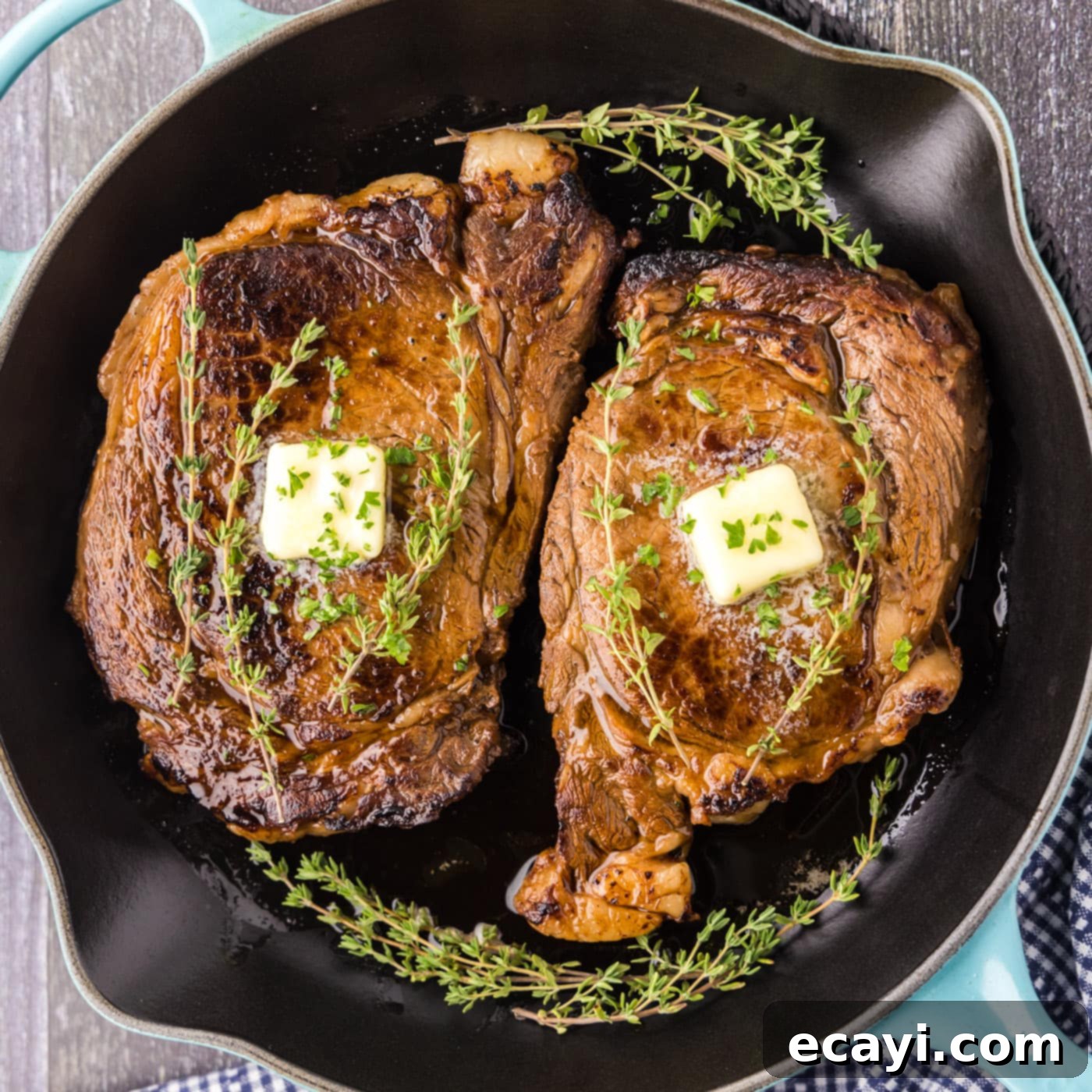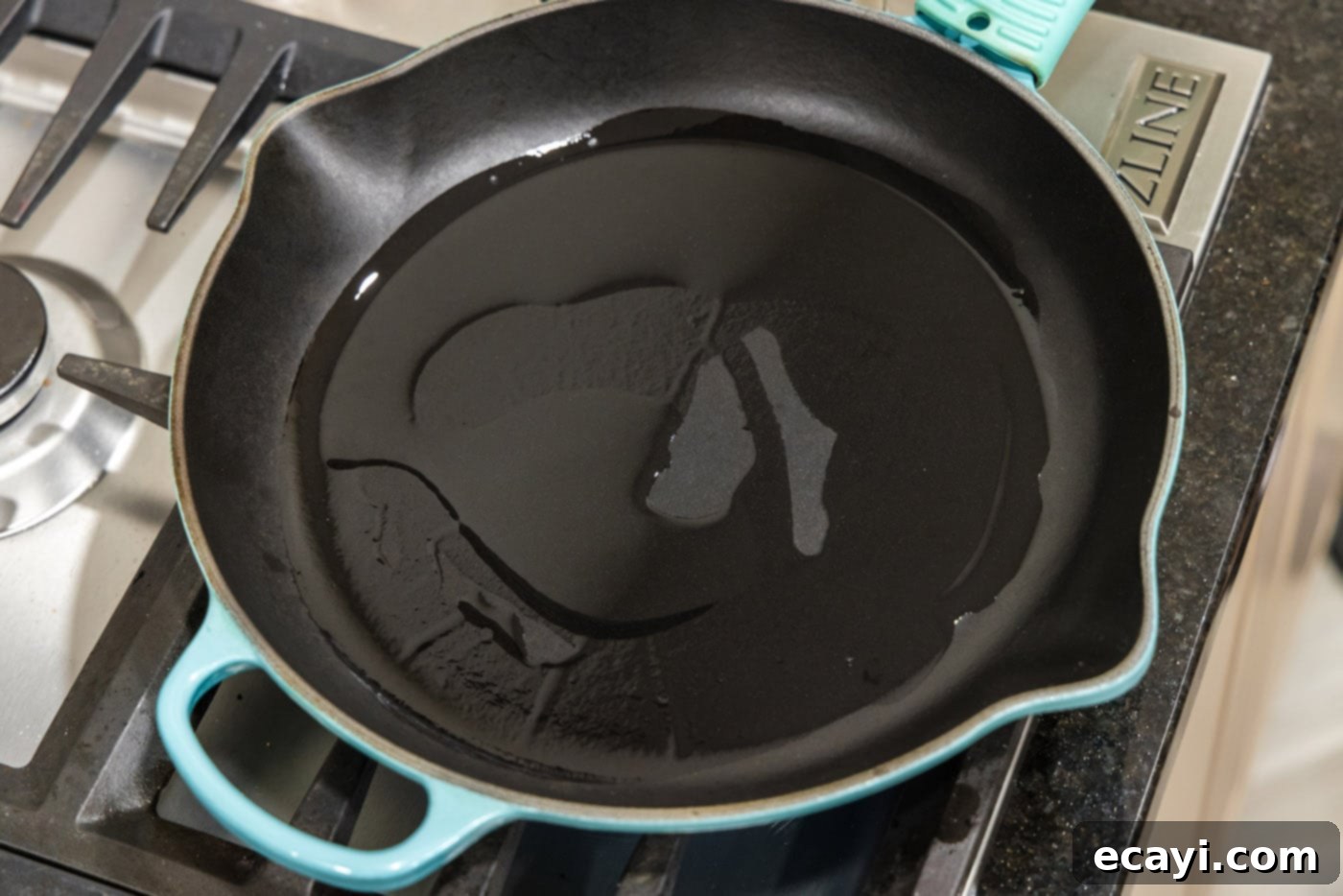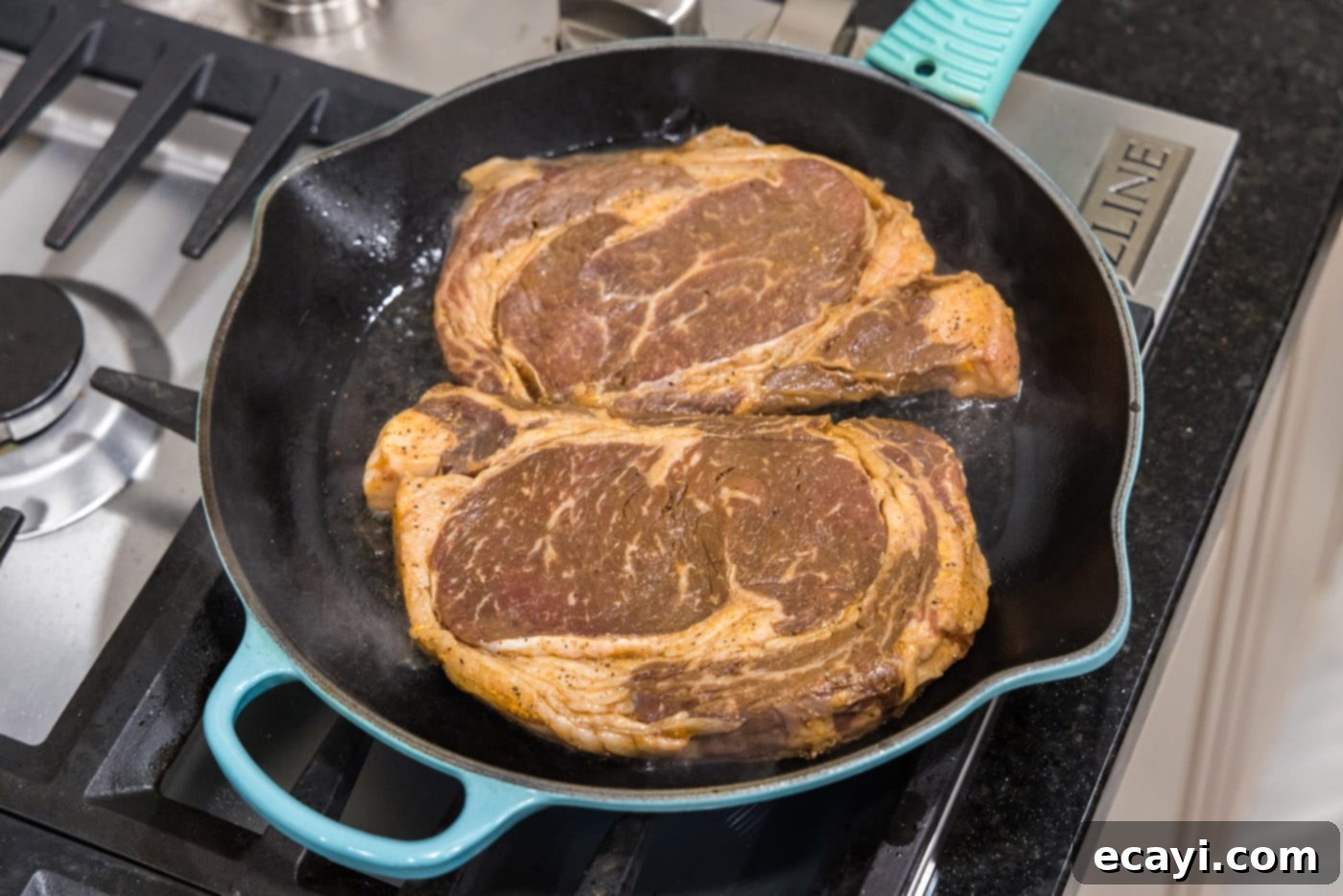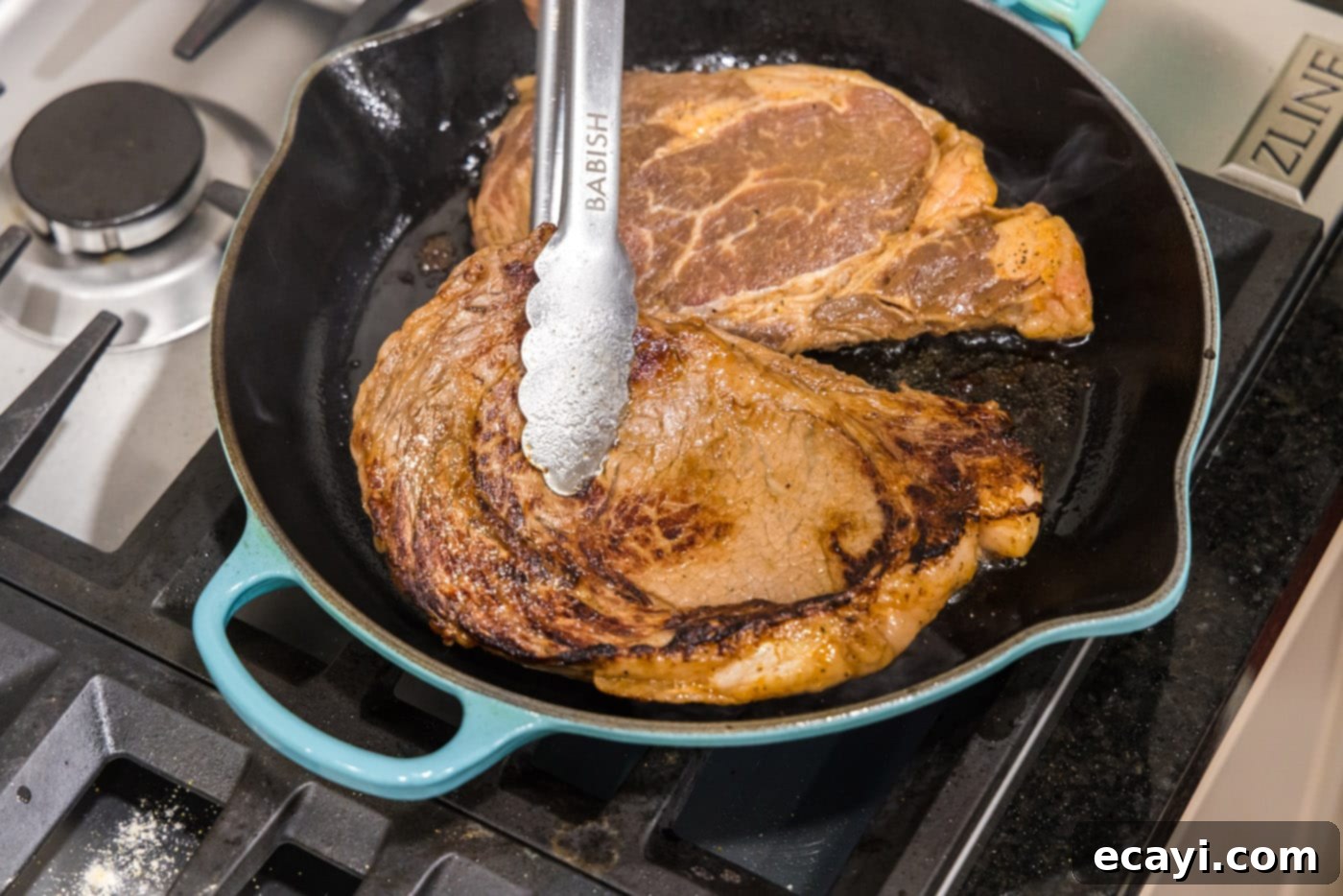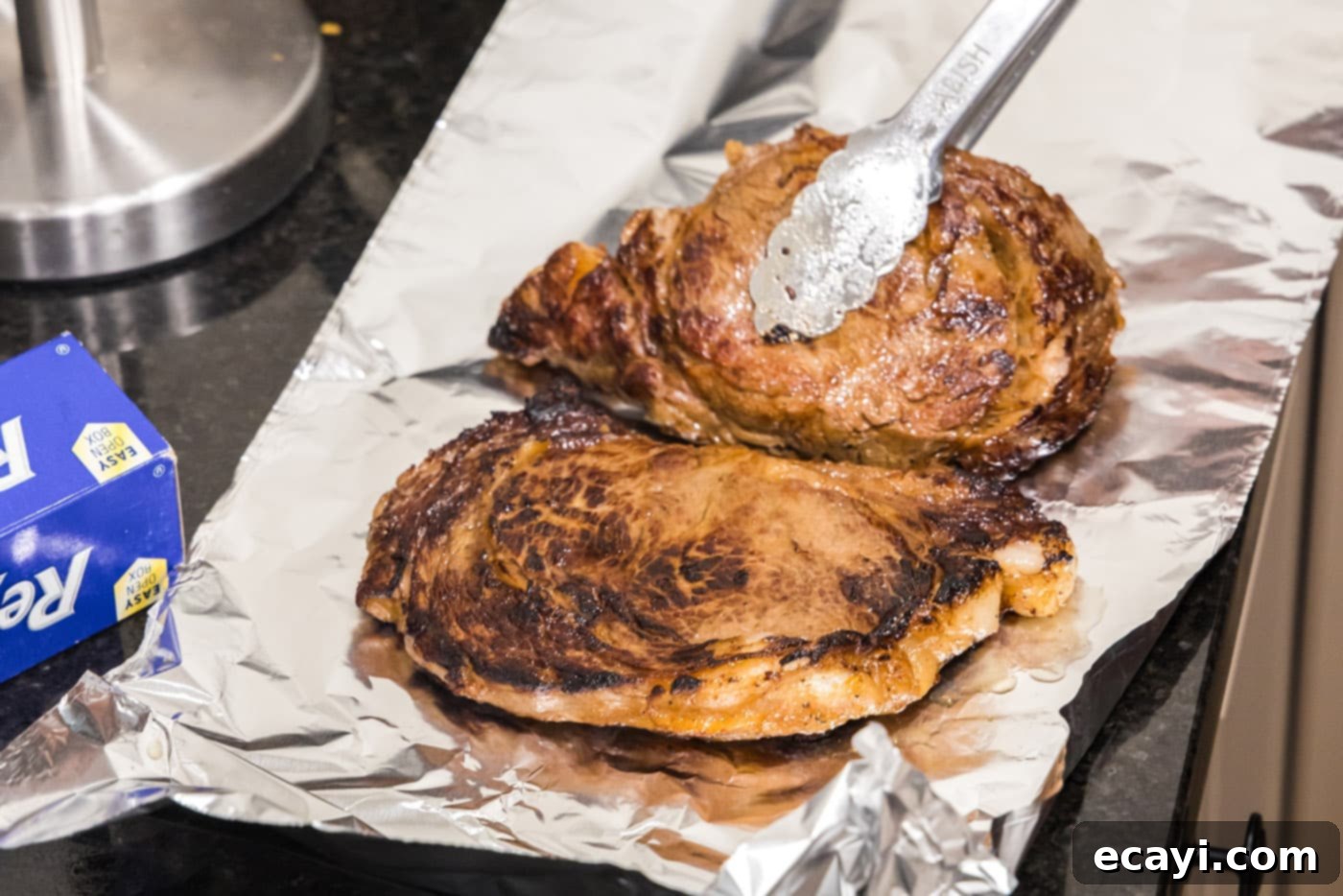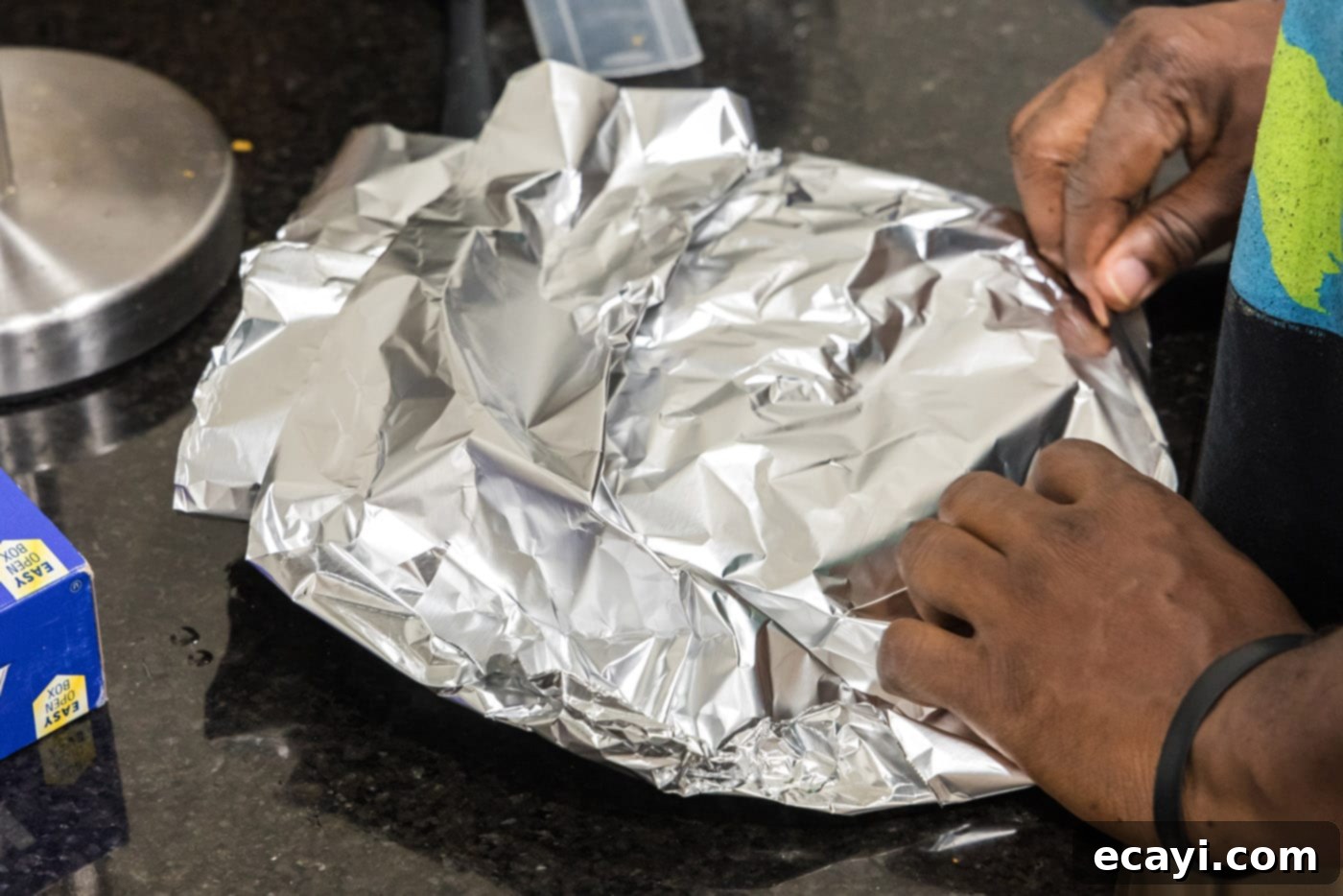Perfectly Seared Cast Iron Ribeye: Your Ultimate Guide to a Tender, Flavorful Steak
Prepare to elevate your home cooking with this exceptional cast iron ribeye recipe. Imagine a steak so tender it practically melts in your mouth, enveloped in a rich, savory marinade, and finished with an irresistible, deeply browned crust. This recipe delivers exactly that, transforming a premium cut of beef into a restaurant-quality meal in under 25 minutes total cook time. Whether you’re a seasoned chef or a beginner in the kitchen, mastering the cast iron sear will change your steak game forever, offering unparalleled flavor and texture that other cooking methods simply can’t match.
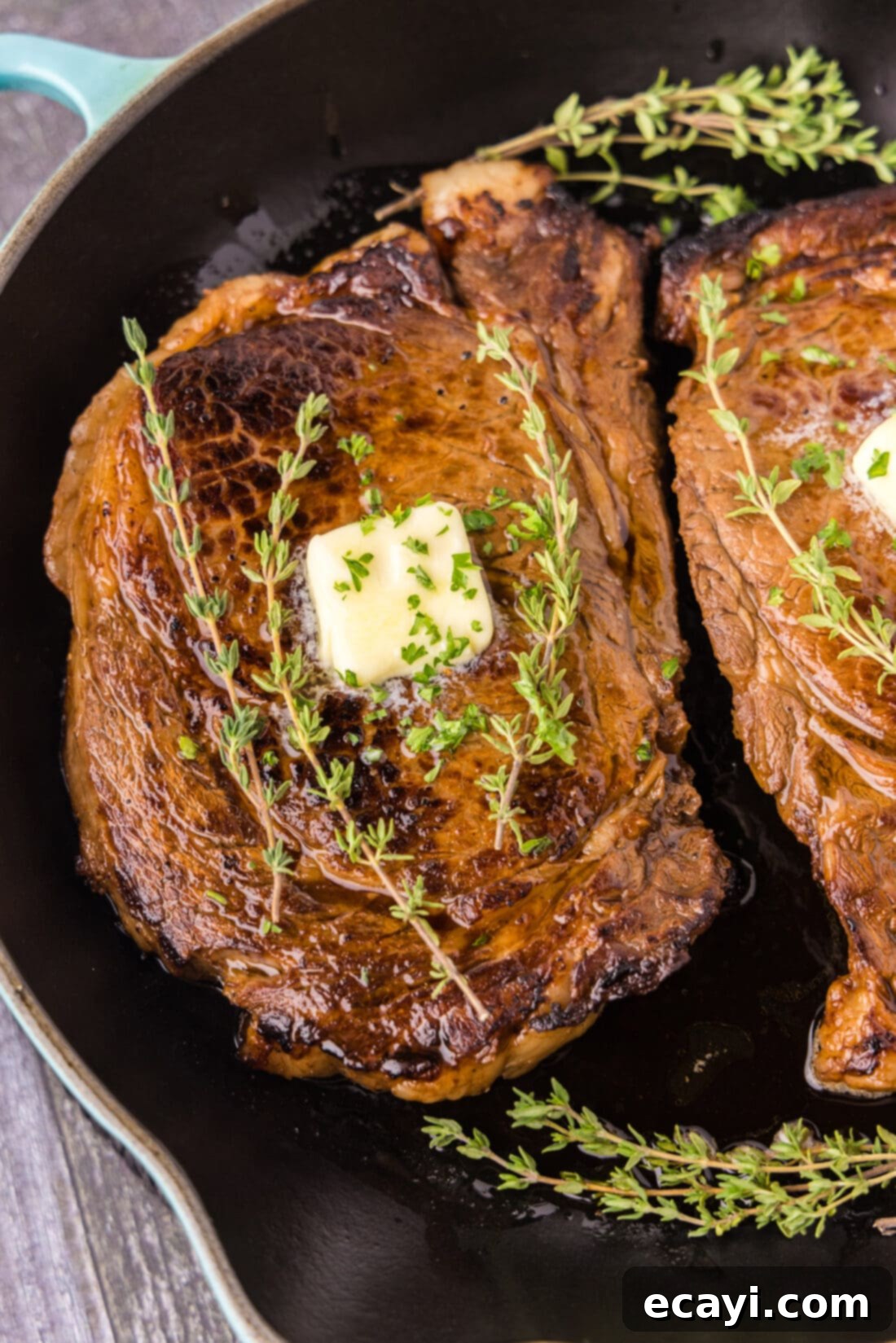
Why This Cast Iron Ribeye Recipe Works Wonders
This cast iron ribeye recipe isn’t just good; it’s foolproof, thanks to a few key elements. First, the strategic use of a flavorful ribeye marinade. While ribeye is already a naturally tender cut, marinating it infuses every fiber with deep, savory notes, pre-tenderizes the meat even further, and reduces overall cooking time. This means you get a more flavorful and succulent steak with less effort and quicker results.
Second, the magic lies in the cast iron skillet. Cast iron is renowned for its ability to retain and distribute heat incredibly evenly. This uniform heat is crucial for achieving that coveted, dark, and crispy crust (the Maillard reaction!) that’s impossible to get with conventional pans. The high heat of the cast iron creates a beautiful sear on the exterior while locking in the juices, ensuring a perfectly cooked, juicy interior. The combination of a tenderizing marinade and the intense, even heat of the cast iron skillet truly makes this recipe a winner for anyone craving a truly spectacular steak experience at home.
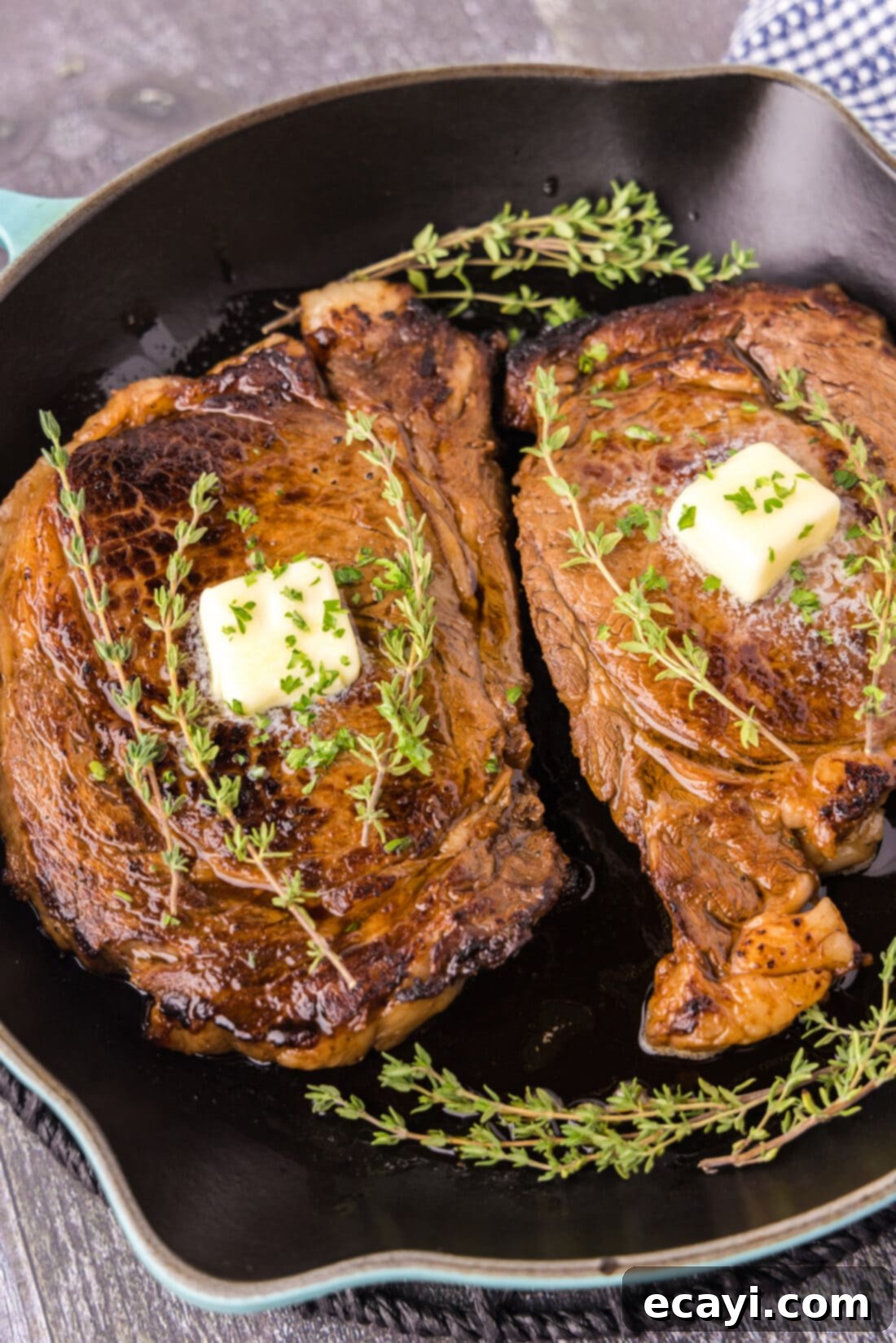
Choosing the Perfect Ribeye Steak
The foundation of any great steak recipe starts with selecting the right cut. For this cast iron ribeye, look for steaks that are at least 1 to 1.5 inches thick. This thickness allows for a beautiful sear on the outside without overcooking the inside. The most important characteristic to observe is the marbling – the fine streaks of fat woven throughout the muscle. Good marbling is a hallmark of a high-quality ribeye and is essential for both flavor and tenderness, as this fat renders down during cooking, basting the meat from within and contributing to that melt-in-your-mouth texture. Don’t be afraid of a bit of exterior fat; it adds to the richness and flavor profile. While you can trim off excessive, hard fat, avoid removing too much, as it plays a crucial role in the cooking process.
Essential Ingredients for Your Cast Iron Ribeye
Crafting the perfect cast iron ribeye requires just a few quality ingredients. You’ll find a detailed list with all measurements and instructions in the printable recipe card at the very end of this post. Here’s a quick overview of what you’ll need to gather:
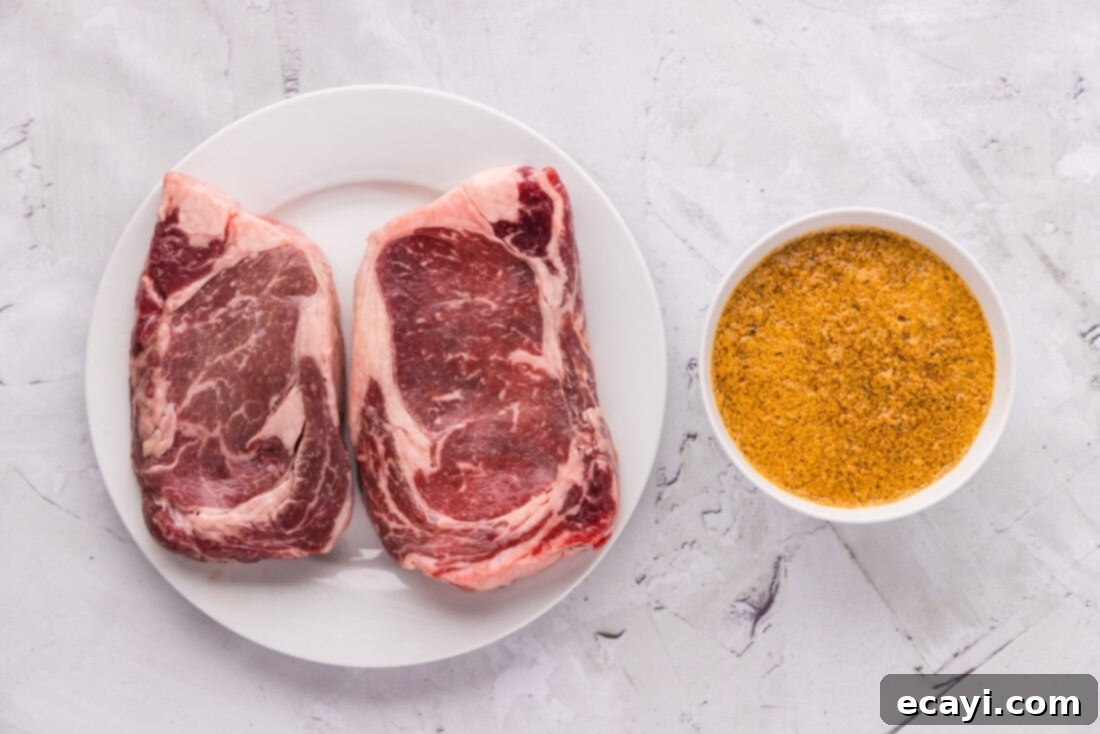
Ingredient Info and Substitution Suggestions
- Ribeye Steaks: As mentioned, opt for boneless ribeye steaks with excellent marbling, about 1 to 1.5 inches thick. This cut is celebrated for its rich flavor and tenderness. If you can’t find ribeye, New York strip or even a thick sirloin can be used, though cooking times and tenderness may vary slightly.
- Olive Oil: Use a good quality olive oil with a high smoke point. It’s essential for achieving a perfect sear in the hot cast iron. Vegetable oil or grapeseed oil are also suitable alternatives if you prefer.
- Ribeye Marinade: This recipe truly shines with Chef Antoine’s signature ribeye marinade. It’s designed to tenderize and infuse maximum flavor. If you’re short on time or prefer a simpler approach, you can skip the marinade. In that case, generously season your steaks with coarse sea salt and freshly ground black pepper. Remember that skipping the marinade will require an increase in cook time by approximately five minutes to achieve desired doneness, and the tenderness will primarily come from the quality of the cut and proper cooking technique.
How to Make the Best Cast Iron Ribeye
These step-by-step photos and instructions are here to help you visualize how to make this delicious recipe. For a complete, printable version with all measurements and detailed instructions, simply Jump to Recipe at the bottom of this post.
Cooking a perfect ribeye in a cast iron skillet is surprisingly simple, yet yields incredibly impressive results. Follow these steps for a steakhouse-quality experience at home:
- Prepare the Steaks: If you’ve marinated your steaks using our recommended ribeye steak marinade, remove them from the marinade and pat them thoroughly dry with paper towels. Removing excess moisture is crucial for achieving that desirable crispy crust. Allow the steaks to sit at room temperature for about 20-30 minutes before cooking; this helps them cook more evenly.
- Preheat Your Cast Iron Skillet: Place your cast iron skillet over medium-high heat. Add the olive oil and allow it to heat until it shimmers and just begins to smoke lightly. This indicates the pan is hot enough for a proper sear. A well-preheated pan is key to preventing sticking and developing a fantastic crust.

- Sear the Steaks: Carefully add both steaks to the hot skillet, ensuring not to overcrowd the pan (cook in batches if necessary). Let them sear undisturbed for 5 minutes. Resist the urge to move them; this static contact with the hot surface is what creates the deep, flavorful crust.

Then, using tongs, turn the steaks over and sear on the other side for another 5 minutes. For a more even cook and an all-around crust, continue turning the steaks, searing for 3 minutes per side for one more rotation. This method ensures a beautiful exterior and allows you to build the crust incrementally.

- Rest and Serve: Once the steaks have reached your desired internal temperature (see our expert tips below for doneness guidance), remove them from the skillet. Immediately wrap them loosely in aluminum foil. Allow the steaks to rest in the foil for at least 5 minutes (or up to 10 minutes for thicker cuts) before slicing and serving. This resting period is crucial for redistributing the juices throughout the meat, resulting in a significantly more tender and flavorful steak. Skipping this step will result in juices running out onto your cutting board, leaving you with a drier steak.


Frequently Asked Questions & Expert Tips for Success
Achieving the perfect doneness is key to a great steak. We recommend using an instant-read thermometer for accuracy. For a medium-rare ribeye, cook to an internal temperature of 130-135°F. If you prefer medium, aim for 135-140°F, and for medium-well, target 140-145°F. Remember that the steak’s temperature will continue to rise by 6-10 degrees as it rests in the foil (this is called carryover cooking), so remove it from the heat just before it reaches your target temperature.
While ribeye is inherently a tender and flavorful cut of beef, marinating it significantly enhances its taste and can further tenderize any tougher connective tissues, especially within the fat. Even a short marinade of 2 hours can make a noticeable difference in infusing deep, complex flavors. If you prefer to skip the marinade, simply season generously with salt and pepper. Be aware that unmarinated steaks might require an extra 5 minutes of cooking time to achieve the same internal doneness and desired crust.
For searing steak in a cast iron skillet, you need an oil with a high smoke point that can withstand the high heat without burning and imparting off-flavors. Olive oil is a good choice, but vegetable oil, grapeseed oil, canola oil, or even clarified butter (ghee) are excellent alternatives. Avoid butter for the initial sear, as its low smoke point means it will burn quickly, but it can be added at the very end for flavor.
Absolutely! For an extra layer of flavor, once you’ve flipped the steak for the last time (about halfway through the final searing stage), you can add a tablespoon or two of unsalted butter to the pan. You can also add crushed garlic cloves, sprigs of fresh rosemary, or thyme. Tilt the pan slightly and use a spoon to baste the melting butter and aromatics over the steak continuously. This “butter basting” technique adds incredible depth and a glossy finish.
Cleaning cast iron is simpler than it seems. While the pan is still warm (but not scorching hot), scrape out any food bits with a stiff brush or a flat metal spatula. For stubborn bits, you can add a little coarse salt as an abrasive and scrub. Rinse with hot water, but avoid soap unless absolutely necessary (and even then, use sparingly, as it can strip seasoning). Immediately after rinsing, thoroughly dry the skillet on the stovetop over low heat for a few minutes. Once dry, lightly rub the entire surface with a thin layer of cooking oil (like vegetable or grapeseed oil) to maintain its seasoning. Store in a dry place.
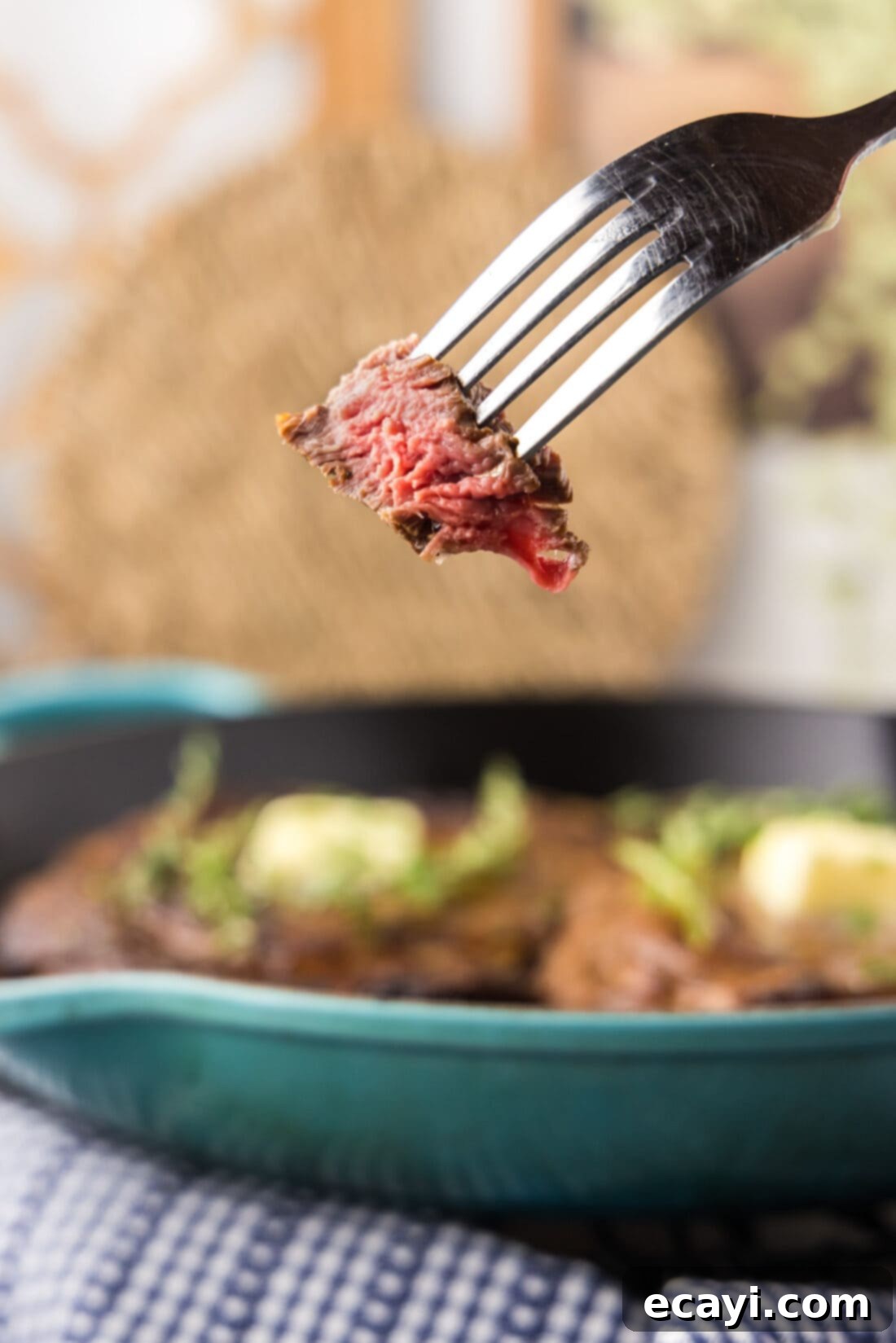
Delicious Serving Suggestions for Your Ribeye
A perfectly cooked cast iron ribeye deserves equally delicious accompaniments. For a classic pairing, serve it alongside creamy mashed potatoes or a healthier alternative like mashed sweet potatoes. For something a bit more indulgent, twice baked potatoes are always a hit. Complement the rich flavor of the steak with vibrant roasted vegetables such as tender roasted carrots, crisp asparagus, or steamed broccoli. For a refreshing contrast, a hearty wedge salad drizzled with creamy blue cheese dressing is an excellent choice, cutting through the richness of the steak beautifully.
Explore More Steak Recipes
If you’ve enjoyed mastering this cast iron ribeye, you’ll love exploring other steak cooking methods and marinade variations. Here are some more of our favorite steak recipes to inspire your next culinary adventure:
- Grilled Steak: For those perfect char marks and smoky flavors.
- General Steak Marinade: A versatile marinade that works for any cut.
- Ribeye Steak Marinade: The specific marinade that makes this recipe sing.
- Smoked Ribeye Steak: For a deep, slow-cooked flavor experience.
- Bacon Wrapped Filet Mignon: An elegant and indulgent choice.
- Air Fryer Steak: A quick and easy method for crispy exteriors.
I love to bake and cook and share my kitchen experience with all of you! Remembering to come back each day can be tough, that’s why I offer a convenient newsletter every time a new recipe posts. Simply subscribe and start receiving your free daily recipes!

Cast Iron Ribeye
IMPORTANT – There are often Frequently Asked Questions within the blog post that you may find helpful. Simply scroll back up to read them!
Print It
Pin It
Rate It
Save ItSaved!
Ingredients
- 2 boneless ribeye steaks about 2 pounds, 1-1.5 inches thick
- 2 Tablespoons olive oil (or other high smoke point oil)
- ribeye marinade (enough for 2 steaks, or use salt & pepper)
- Optional: 2 tbsp butter, fresh rosemary/thyme, garlic cloves (for basting during the last few minutes)
Things You’ll Need
-
Cast iron skillet
-
Instant-read meat thermometer
-
Vinyl gloves
(optional, for handling marinated meat)
-
Tongs
Before You Begin
- Chef Antoine’s cast iron ribeye steak is marinated first using his ribeye marinade here, which is linked above in the ingredients list. Alternatively, you can simply season the steaks with salt and pepper and increase the cook time by five minutes. Marinating the steak first will tenderize the meat and allow for a shorter cook time, while simultaneously infusing rich, mouth-watering flavor into an already juicy cut of beef.
- Look for ribeye steaks with nice marbling throughout, ideally 1 to 1.5 inches thick. Ribeyes can have a lot of fat on them. You can trim off some of the excess, but not too much, as the fat helps with the flavor and creates a delicious crust during cooking.
- Cook ribeye steak to an internal temperature of 130-135°F for medium-rare and 140-145°F for medium to medium-well. Use an instant-read thermometer for precision. Keep in mind that the steak will continue to rise 6-10 degrees in temperature as it rests in the foil, so factor in this carryover cooking.
- Always bring your steaks to room temperature for 20-30 minutes before cooking. This ensures a more even cook from edge to center.
Instructions
-
Pat dry marinated steaks thoroughly with paper towels. Allow them to come to room temperature for 20-30 minutes for best results.
-
Heat olive oil in a cast iron skillet over medium-high heat until shimmering and just starting to smoke lightly.
-
Carefully add both steaks to the hot skillet. Sear for 5 minutes without moving. Flip and sear on the other side for 5 minutes. Then, turn one more time on each side, searing for 3 minutes per side, for a total of 16 minutes cooking time (adjust as needed for doneness and steak thickness).
-
Remove from skillet, wrap loosely in foil, and allow to rest for 5-10 minutes before slicing and serving. This resting period is essential for a juicy steak.
Nutrition
The recipes on this blog are tested with a conventional gas oven and gas stovetop. It’s important to note that some ovens, especially as they age, can cook and bake inconsistently. Using an inexpensive oven thermometer can assure you that your oven is truly heating to the proper temperature. If you use a toaster oven or countertop oven, please keep in mind that they may not distribute heat the same as a conventional full sized oven and you may need to adjust your cooking/baking times. In the case of recipes made with a pressure cooker, air fryer, slow cooker, or other appliance, a link to the appliances we use is listed within each respective recipe. For baking recipes where measurements are given by weight, please note that results may not be the same if cups are used instead, and we can’t guarantee success with that method.
